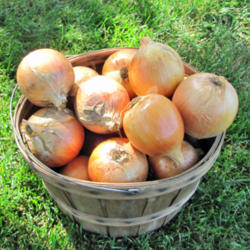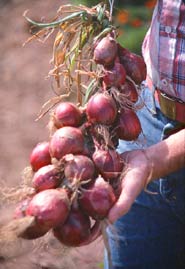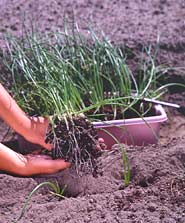
'Vidalia', 'Texas Supersweet', 'Walla Walla Sweet' ... sweet onions are becoming the rage across the country. "In the last five years, we've seen a big increase in demand for sweet onions -- and it's continuing to grow," notes Bucky Parker, general manager at Piedmont Plant Company, growers of more than 15 million onion transplants in Albany, Georgia. Onions imported from as far away as Chile and New Zealand are called "sweet onions," but since there are no national standards on what constitutes a sweet onion, growing sweet varieties yourself is the best way to go.
In many areas of the country, Fall is the time to start growing these mild-flavored, large-sized globes for spring. There are just three ideas to keep in mind for a bumper sweet onion harvest: Choose the right varieties for your area, plant at the right time and keep the onions as stress-free as possible.
What Makes an Onion SweetSweetness in onions is more accurately termed "lack of pungency or mildness." Sugar levels really don't determine if an onion will be sweet. "Some pungent onions actually have more sugar in them than 'sweet onions,' but the sugar is masked by a high amount of sulfur compounds," explains Bill Randle, onion expert at the University of Georgia in Athens. "The low amount of sulfur compounds in sweet onions allows the sugar flavor to come through."
"Though there's no national standard for what constitutes a sweet onion, researchers at New Mexico State University and University of Georgia have developed a test to compare the sweetness of differ onion varieties. The pyruvic acid test combined with a sensory rating scale gives us an idea of onion pungency," explains Randle. The rating scale is 1 to 18. An onion that scores 1 has very little pungency when eaten raw. "At 4 the onion taster begins to feel some heat, and anything above 6 you can't comfortably eat raw," he says.
"Most sweet onions such as Vidalias and Texas Supersweets score between 2.5 and 4.0. It's primarily the genetics of onions that make them pungent or sweet, but the sulfur content of the soil and poor growing conditions can add to the pungency," adds Randle. The higher the soil sulfur content, the more pungent the onion. That's one reason areas of the country with naturally low sulfur levels, such as Vidalia, Georgia, are known for their sweet onions. It's a delicate balance between having enough sulfur for proper plant growth, but keeping sulfur levels low so the onion stays mild," explains Randle.
Any stress while the onion is growing also tends to make it more pungent. "There is a natural variation of sweetness in onions from year to year, depending on the weather, fertility and any insect and disease damage to the crop," Randle notes.
The Short and Sweet of OnionsThe varieties used to grow Vidalias and most other sweet onions are termed short-day varieties. Short-day refers to the hours of daylight required to initiate bulbing. These onions start to develop bulbs when the weather is cool and days are 11 to 12 hours long. The larger the onion plant at the bulb formation time, the larger and sweeter the onion. That's the reason short-day onions are primarily grown in southern latitudes, around 32o north latitude. There, the plants can be started in fall and overwintered to reach maximum size in spring when bulb formation occurs.
This short-day variety latitude line, running from central Georgia, through central Texas, and across southern Arizona, New Mexico and California, isn't poured in bronze, though. Short-day onions can also be successfully grown to 35o north latitude from a fall planting. "We grow short-day onions in warmer parts of North Carolina from a fall planting with no problems. They're just a little later-maturing than those from Georgia and Texas," says Doug Sanders, vegetable specialist at the University of North Carolina in Raeigh.
Even with the proper day length, there's another factor that limits short-day onion culture: cold temperatures.
"Short-day onions are only hardy to about 20° F," says Parker. They can be spring-planted farther north as transplants as soon as the ground can be worked, but the onions don't compare in size and sweetness with the fall-planted ones in the South.
Gardeners living as far north as Portland, Oregon, and New York City can still start some sweet onions this fall, though. There is a class of onions called "intermediate day" that are less day-length sensitive and can be fall-planted. Some rival Vidalias for sweetness. As long as your winter temperatures don't go below 0° F (zone 7 in most areas), these varieties can overwinter.

Granex onions, such as 'Granex 33', are reputedly the sweetest of the sweet onions. The original Granex hybrid was a cross between 'Grano' (with a round, "top" shape) and Bermuda (a flat, saucer shape) onions. 'Granex' is the "Vidalia" onion when grown in Vidalia, Georgia. The same variety grown near Tyler, Texas is called the "Noonday" onion, and when grown in Hawaii, it's the "Maui Sweet."
Granos, also very popular and sweet, are grown commercially from Texas west to California. 'Texas Grano 502' and 'Texas Grano 1015' are two of the most popular varieties; the latter is familiar as the "Texas Supersweet." At New Mexico State University, which has one of the most active breeding programs for sweet onions, researchers have introduced varieties for the Southwest such as the 'New Mexico Grano' and 'New Mexico White Grano'.
Bermuda onions aren't favored by commercial growers because of their low yields compared with Grano and Granex types, but they're still great for home gardeners. "Excel," the common name of 'Bermuda 986', is a good selection of a Bermuda onion that's sweet and grows well for a home gardener," says Joe Corgan, onion breeder at New Mexico State University in Las Cruces.
"When in doubt about which short-day variety to grow in your area, try growing a few rows of each. You can have a six-week harvest of sweet, short-day onions starting in April by growing varieties that mature at different times such as 'Granex 33', 'Grano 502' and 'Grano 1015'," notes Rick Jones, short-day onion breeder at Asgrow Seed Company in College Station, Texas.
In the intermediate-day onion class, 'Walla Walla Sweet' is still hard to beat for sweetness and cold tolerance. However, a new hybrid called 'Candy' has tested almost as sweet as Vidalia in some trials. And sweet red onions give gardeners more options. 'Stockton Red' and 'Italian Red Torpedo' are "mildly pungent," meaning they're not as sweet as a Vidalia or Walla Walla, but they're sweeter than many other onions on the market. (In general, red and white onions are not as sweet as yellows.)

For the biggest, sweetest harvests, late summer and early fall are the prime times to sow seeds of short- or intermediate-day onions. "Fall-sown short- and intermediate-day onions tend to yield more and are larger and sweeter than those seeded or transplanted in early spring," notes Rick Watson, onion breeder at Sunseeds in Brooks, Oregon. Sow seeds of short-day onions in a flat indoors or directly into the garden. Mid-October is usually the best time in the South because the weather is cooler and summer weeds don't germinate after this date.
Sow seeds of intermediate-day onions earlier -- late August in the Pacific Northwest and September in the Southwest and Southeast.
"Buying transplants is probably easier for many home gardeners than trying to germinate and grow the right-size seedling before winter," notes Parker. Just add about eight weeks to the seeding date for the proper transplanting date in your area. However, the number of transplant varieties available are fewer and the price for them is much more expensive than for seed. And what you can buy in fall and winter will vary depending on your region of the country.
Whether using transplants or seeds, prepare the ground ahead of time. Since onions like a well-drained, crumbly, fertile soil, raised beds work well. Work a two-inch layer of compost into the bed before planting in fall. At planting, apply a complete fertilizer such as 10-10-10 at 1/2 cup per 20-foot row. Although onions are heavy feeders, save most of your fertilizing until spring when the bulbs begin to form.
For direct sowing, sprinkle seeds in double rows on the raised beds and cover them with a 1/4-inch layer of sand or vermiculite. Keep the bed moist and weed-free -- onions need a constant supply of water and little competition from weeds. Thin seedlings (or transplant indoor onion starts) four inches apart with 12 inches between rows. Mulch transplants with a one- to two-inch layer of finely chopped hay to conserve moisture and help keep weeds down.
For cold areas where you're pushing the limit of overwintering, the plants may need protection. Use a floating row cover to cover transplants in November to help keep winter minimum temperatures above 0? F.
Once new growth starts in spring, sidedress twice, one month apart, with 1/4 cup of blood meal per 10-foot row. Avoid sulfur-based chemical fertilizers such as ammonium sulfate, and don't apply fertilizer within 30 days of harvest, or you may increase the onion's pungency.
Begin harvesting when one-fourth of the tops have naturally flopped over. Short-day varieties are usually ready to harvest from April to June. Intermediate-day varieties are harvested from May to July. Sweet onions are notorious for not being good keepers--sometimes they only last a few weeks in storage. But there always are exceptions to the rule.
A traditional method of storing sweet onions is to cure them for two to three days after harvest in the sun, then store them in the legs of old panty hose, tieing a knot after each onion and hanging them in a cool, well-ventilated place. "I've kept short-day onions for three to four months by wrapping them individually in paper towels and placing them in the refrigerator, notes Parker. That would be just about the right time to start seeding another great crop of sweet onions for next year!"
Best Sweet Onions for Fall PlantingThese are the top varieties for planting now to get sweet onions next spring. "OP" indicates the variety is open-pollinated, and "H" means it is a hybrid.
Short-Day Onions'Excel' ('Bermuda 986'). OP. Thick, flattened shape. Light yellow skin, white flesh. Good bolt and splitting resistance. Better for storing than other Bermuda onions.
'Granex 33' ('Yellow Granex'). H. Flattened globe shape. Thin, yellow skin, very sweet white flesh. Bolt resistant. Commonly grown in Vidalia, Georgia, and Maui, Hawaii. The red and white versions are not as mild-tasting.
'Red Burgundy'. OP. Thick, flattened shape. Red skin, white flesh, fine texture. A good slicer.
'Texas Grano 502'. OP. Softball-sized. Thin yellow skin, white flesh. Disease resistant. Earlier than 'Texas Grano 1015'.
'Texas Grano 1015' ('Texas Supersweet'). OP. Large, flattened globe shape. Thin yellow skin, white flesh. Disease tolerant. Well adapted to South Texas.
'White Bermuda' ('Crystal Wax'). H and OP forms. Thick, flattened shape. White skin, delicate-flavored flesh. Also a red version.
Intermediate-Day Onions'Candy'. H. Large, flattened globe shape. Light brown skin, white flesh. Sweet taste, high yields. Seed one month later than other intermediate-day onions above 40oN.
'Cimmaron'. H. Globe shape. Thin yellow skin, white flesh, thick rings. Mildly pungent. Disease tolerant. Seed one month later than other intermediate-day onions above 40oN.
'Italian Red Torpedo'. OP. Tall, bottle shape. Purple-red skin; light red, soft flesh. Mildly pungent. Nonbolting. Disease resistant.
'New Mexico White Grano'. OP. Large "top" shape. White skin and flesh. Adapted to the Southwest. Also a yellow version.
'Stockton Red'. OP. Flattened globe shape. Thin red skin, whitish pink flesh. Mildly pungent. Not as hardy as Walla Walla Sweet but a good variety for the West. Also a yellow version.
'Super Star'. H. The first hybrid onion to win the All-America Selections Award.
'Walla Walla Sweet'. OP. Large, flattened globe shape. Yellow skin, light yellow flesh, very sweet. Good cold tolerance. Standard variety for the Northwest.
Charlie Nardozzi is a senior horticulturist at National Gardening.
Photography by National Gardening Association
 Charlie Nardozzi is an award winning, nationally recognized garden writer, speaker, radio, and television personality. He has worked for more than 30 years bringing expert gardening information to home gardeners through radio, television, talks, tours, on-line, and the printed page. Charlie delights in making gardening information simple, easy, fun and accessible to everyone. He's the author of 6 books, has three radio shows in New England and a TV show. He leads Garden Tours around the world and consults with organizations and companies about gardening programs. See more about him at Gardening With Charlie.
Charlie Nardozzi is an award winning, nationally recognized garden writer, speaker, radio, and television personality. He has worked for more than 30 years bringing expert gardening information to home gardeners through radio, television, talks, tours, on-line, and the printed page. Charlie delights in making gardening information simple, easy, fun and accessible to everyone. He's the author of 6 books, has three radio shows in New England and a TV show. He leads Garden Tours around the world and consults with organizations and companies about gardening programs. See more about him at Gardening With Charlie.
 Victory Seed Company has all the seeds you want for your best garden in 2024.
Victory Seed Company has all the seeds you want for your best garden in 2024.
For 25 years, the family-owned Victory Seed Company has provided the highest quality vegetable, herb and flower seeds to families across the country. We are passionate about providing you the best seeds available that give excellent germination, robust plants, and the harvest you want. With a catalog of over a thousand varieties, we have everything, and our prices are the kinds that we'd want to pay. We have hundreds of yesterday's heirloom vegetables, as well as today's award winning hybrid selections. Get to know us by visiting our website and browsing through our online vegetable seed catalog.